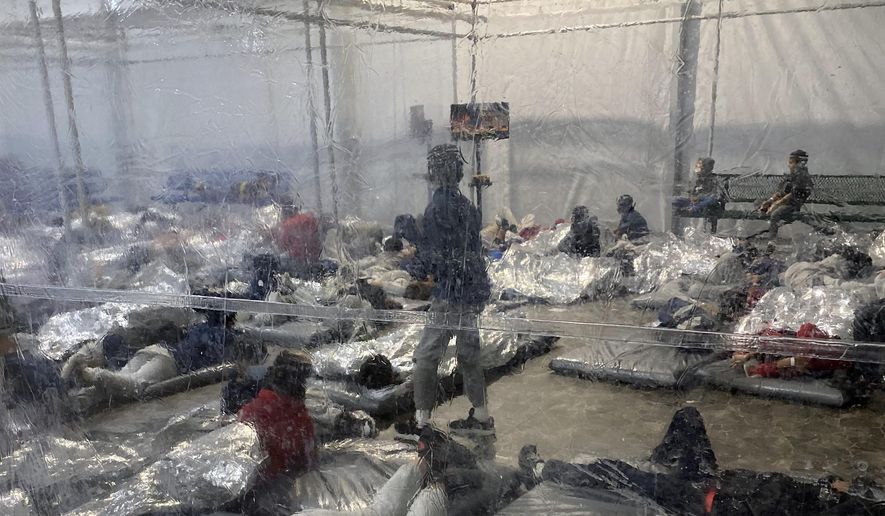The Biden administration was so unprepared for the surge of migrant children last year that it was unable to deliver adequate care, leading some children to experience panic attacks and sending others to potentially unsafe homes, an inspector general revealed Tuesday.
Untrained volunteers were put in charge of decisions about where to send the children, and they sometimes failed to consider a child’s history of abuse or the presence of a sex offender in the home they approved, the Health and Human Services inspector general said.
The overwhelming numbers of minors who rushed the border — spurred by policy changes the Biden team made — forced the feds to open emergency tent cities to house the children. The numbers were so extreme that officials struggled to provide basic care. Some went weeks without talking to the case manager who was supposed to be helping them.
That led to panic attacks, the inspector general said. One staffer reported “a pervasive sense of despair.” Another reported watching a young girl hit and cut herself after learning that authorities hadn’t even contacted her mother yet.
“Kids would say, ‘I haven’t talked to my case manager in 48 days.’ They had a sense that they had been forgotten,” one staffer told investigators. “One girl kept saying she didn’t know what was going on, and one day she broke down and said she couldn’t take it any more.”
The case workers blamed the overwhelming crush of minors.
Some were handling as many as 35 children at the height of the spring 2021 surge but the administration managed to bring those numbers down to fewer than five cases per manager by July 2021.
Staffers who raised concerns about the children’s safety faced retaliation, the probe found.
One agency leader reported being demoted after complaining about conditions at the tent cities and the Biden administration’s more relaxed standards for vetting sponsors who wanted to take the children.
The retaliation seems to have worked, though. Other staffers told the inspector general they were “hesitant” to report problems because they feared the blowback.
“They did everything possible to discourage people from discussing what was going on,” one staffer told the probe.
The children in question were unaccompanied juveniles, who showed up at the border without parents.
Under the law, most are supposed to be quickly processed by Homeland Security and then sent to HHS’ Office of Refugee Resettlement. ORR places them in shelters until sponsors can be found, or until they turn 18.
The Trump administration had shut the border to all immigrants without documentation during the pandemic, which meant turning them back. That included the unaccompanied juveniles. The Biden administration reversed that policy, saying it was cruel to refuse entry to children.
Many children rushed the border.
In October 2020, before the presidential election, the Border Patrol reported apprehending fewer than 4,700 unaccompanied children. In March 2021, just weeks after President Biden’s inauguration, that had soared to more than 18,700.
In its official response, HHS admitted the surge of children was “one of the most challenging periods in ORR’s history.” But the department insisted its decisions were in their best interests.
“As ORR worked quickly to respond to this unprecedented emergency, and with limited resources, it prioritized the safety and wellbeing of children at every step,” Assistant Secretary January Contreras wrote in a lengthy reply to the inspector general.
She said matters have improved dramatically, with minors at the chief emergency tent city now being placed with sponsors in an average of just 14 days. Truly vulnerable children are given high-priority treatment, and the department has imposed stiffer checks to make sure case managers are making good decisions about where kids are placed.
Ms. Contreras said they have taken steps to improve whistleblower training so those raising concerns in the future won’t feel punished — and that extends to contractors, who provide much of the children’s care.
Unaccompanied juveniles are the trickiest of border cases. Truly unaccompanied children are the most vulnerable, with Border Patrol agents reporting finding some younger than a year old.
Parents send children with the knowledge that they will be processed and delivered safely by the government to sponsors — often relatives living here illegally. Many parents will even send their children with birth certificates and the names and phone numbers of their intended sponsors, counting on the federal government to complete the smuggling journey.
But sometimes children are trafficked, with sponsors in the U.S. taking them forced labor or other reasons.
In one horrific case out of Illinois, federal authorities earlier this year said they found a girl who’d come as a 10-year-old, was forced into work, was beaten and slashed with a knife at home, and was raped repeatedly.
Her situation was only uncovered after she suffered a miscarriage and showed up at a hospital.
That girl entered in 2016, during a previous wave of migrant minors. The Trump administration stiffened the checks on sponsors, but the Biden team, faced with the crushing level of children, erased some of those checks in 2021.
From March 2021 through August 2022, the Border Patrol reported nabbing more than 253,000 unaccompanied juveniles.
The inspector general said the numbers were so bad in the early months that some case managers had “no knowledge of child-welfare best practices.” That meant they might be approving children for unsafe conditions.
“Federal field specialist supervisors reported that some inexperienced case managers showed a disregard for long-established child-welfare best practices. In some cases, release recommendations made by these inexperienced case managers reportedly failed to consider children’s significant history of abuse and neglect or whether sex offenders resided in the potential sponsor’s household,” the probe found.
“ORR leaders reportedly received numerous complaints about the quality and thoroughness of some case managers’ work,” investigators said.
• Stephen Dinan can be reached at sdinan@washingtontimes.com.




Please read our comment policy before commenting.